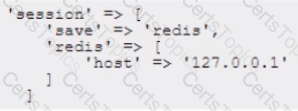An Adobe Commerce Architect is reviewing api-functional test code. Some tests send errors to indicate that the customer address does not exist.
The test codes show the following:

Which steps should the Architect take to fix the test errors?
A)

B)

C)

A merchant notices that product price changes do not update on the storefront.
The index management page in the Adobe Commerce Admin Panel shows the following:
• All indexes are set to 'update by schedule'
• Their status is 'ready'
• There are no items in the backlog
• The indexes were last updated 1 minute ago
A developer verifies that updating and saving product prices adds the relevant product IDs into the catalog_product_price_cl changelog table.
Which two steps should the Architect recommend to the developer to resolve this issue? (Choose two.)
An Adobe Commerce Architect is troubleshooting an issue on an Adobe Commerce Cloud project that is not yet live.
The developers migrate the Staging Database to Production in readiness to Go Live. However, when the developers test their Product Import feature, the new products do not appear on the frontend.
The developers suspect the Varnish Cache is not being cleared. Staging seems to work as expected. Production was working before the database migration.
What is the likely cause?
An Adobe Commerce store owner sets up a custom customer attribute "my.attribute" (type int).
An Architect needs to display customer-specific content on the home page to Customers with "my.attribute" greater than 3. The website is running Full Page Cache.
Using best practices, which two steps should the Architect take to implement these requirements? (Choose two.)
The development of an Adobe Commerce website is complete. The website is ready to be rolled out on the production environment.
An Architect designed the system to run in a distributed architecture made up of multiple backend webservers that process requests behind a Load Balancer.
After deploying the system and accessing the website for the first time, users cannot access the Customer Dashboard after logging in. The website keeps redirecting users to the sign-in page even though the users have successfully logged in. The Architect determines that the session is not being saved properly.
In the napp/etc/env.php\ the session is configured as follows:

What should the Architect do to correct this issue?
In a custom module, an Architect wants to define a new xml configuration file. The module should be able to read all the xml configuration files declared in the system, merge them together, and use their values in PHP class.
Which two steps should the Architect make to meet this requirement? (Choose two.)
A representative of a small business needs an Adobe Commerce Architect to design a custom integration of a third-party payment solution. They want to reduce the list of controls identified in their Self-Assessment Questionnaire as much as possible to achieve PCI compliance for their existing Magento application.
Which approach meets the business needs?